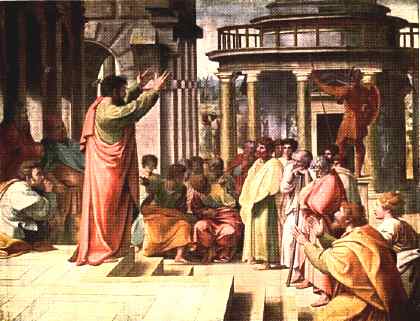Architecture and painting: Raphael (2)
Although for convenience architecture and painting are given separate sections in this program, the two were intimately connected: most painters were also architects, and all were influenced by the simplicity, the balance, and the grace of ancient Greek and Roman buildings. (Click here to read about art as a collective* production.)
In this Cartoon, Raphael is responding to architecture in two ways*. The tapestries were designed to exploit the way the light fell from the windows in the Sistine Chapel where they were to be hung, and were thus as integral to the building as Michaelangelo's paintings. And the picture itself portrays the structures of ancient Athens with the eye of an architect drawing a building he has designed.
See the cartoon reversed, as it appared in the tapestries.
Footnotes
-
Not just a pretty picture
Perhaps in three ways: as this Cartoon shows, Raphael's figures are sometimes more like animated statues than active human beings. Refer to the section "All done with mirrors?" on this page to see how the finished tapestries would have been more dynamic, however.
-
Raphael, et al.
What we for convenience call "Raphael's" Cartoons are a fine example of the different attitude in the Renaissance towards the individual and art. The Cartoons were designed overall by Raphael, and he undoubtedly had a hand in the actual painting; but much of the work was done by assistants, and the final work of art--the tapestries themselves--was created by quite different artisans, a workshop of weavers in Brussels overseen by the weaver Pieter van Aelst.
Thus the tapestries were the result of a collective rather than an individual effort. Our attitude towards art today stresses the individual, with the result that much scholarly fervour is spent on identifying whether a picture was actually by an artist, like Raphael or Tintoretto, or by his assistants working under his direction. In the same way, a great deal of literary detective work has been devoted to trying to decide which lines or scenes are specifically by Shakespeare in works written by him in collaboration with others. (At least three late plays, Pericles, The Two Noble Kinsman, and Henry VIII, are known to have been written only partly by Shakespeare.)
